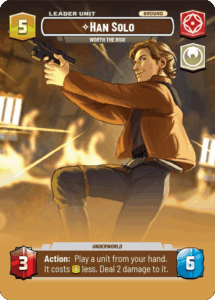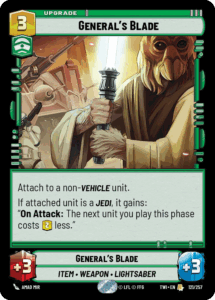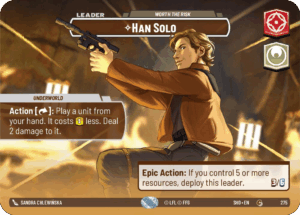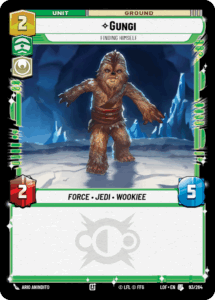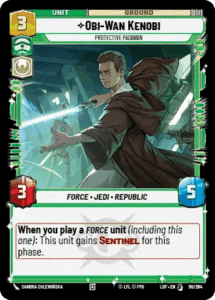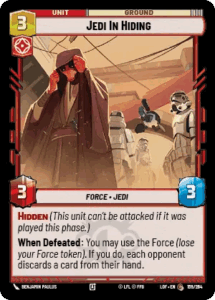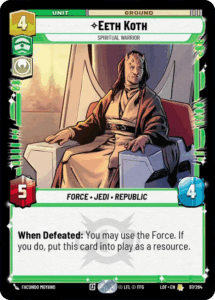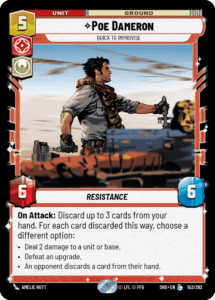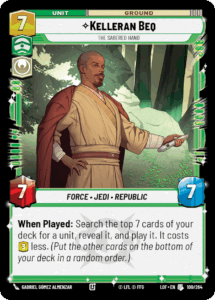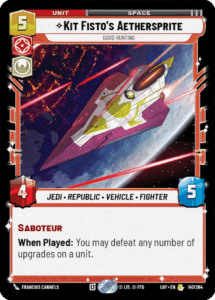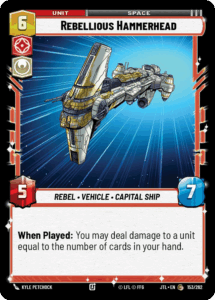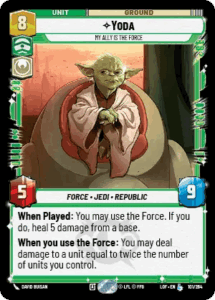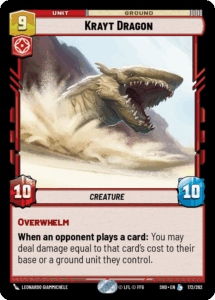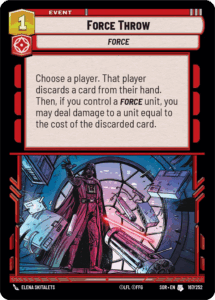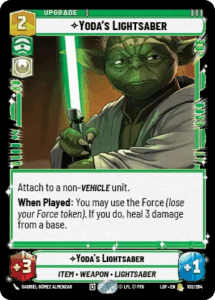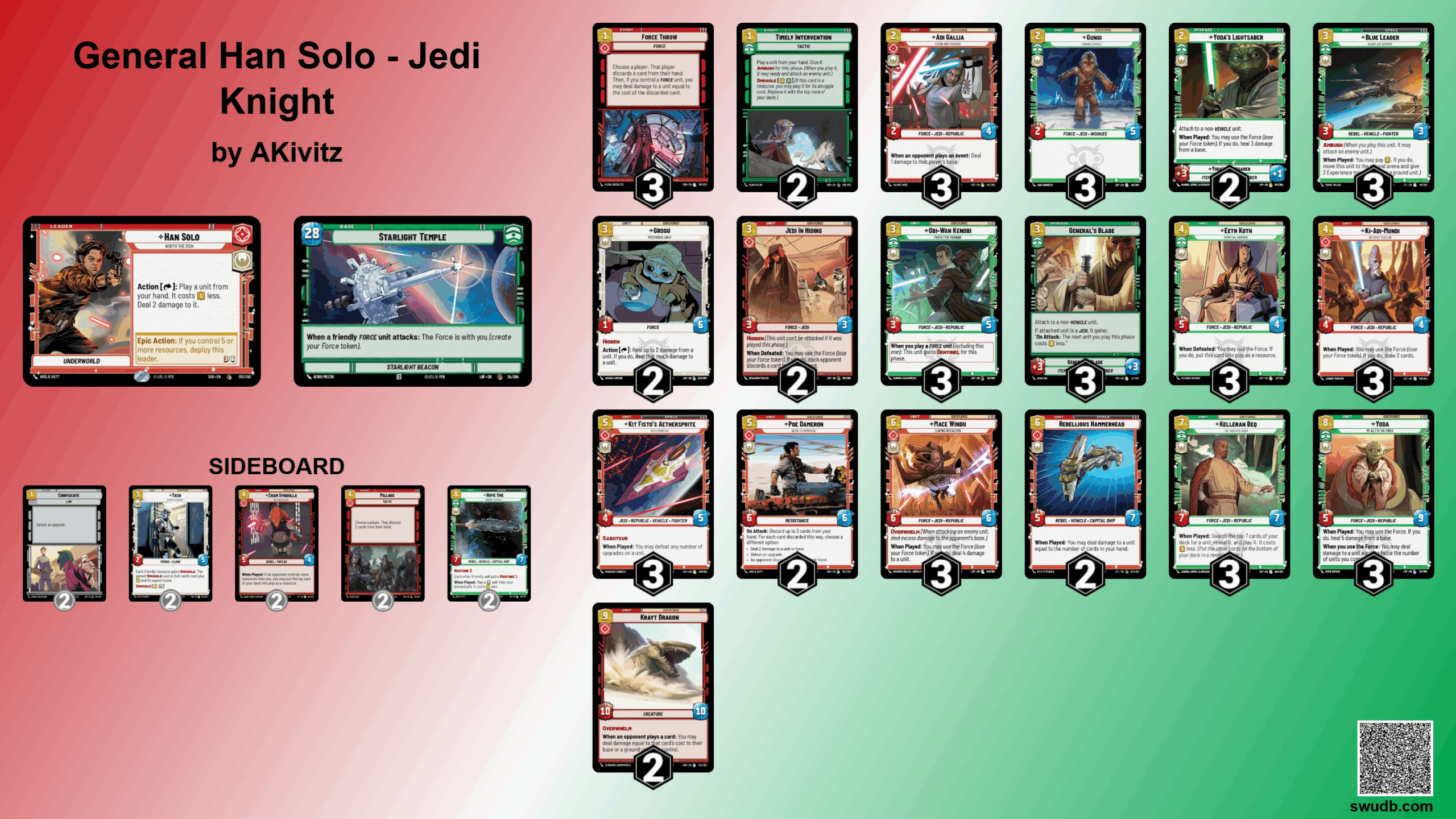The Force Awakens - Legends of the Force: What is a Prerelease
Not only did Legends of the Force just release, but we also have players and teams across the globe frantically testing their decks for the first ever Galactic Championship happening in Las Vegas in two weeks! While looking through the new set, we have some crazy new combinations and decks popping up left and right.
One Leader in particular has caught our eye with just how fast it can play late game powerhouses. Here is the story of Han Solo – Worth The Risk and how he became one of the greatest generals the Jedi Counsel has ever seen.

Alex Kivitz

A Smuggler’s Discount - Han Solo’s Leader Ability
Han Solo – Worth The Risk has the Action ability that says “Play a unit from your hand. It costs 1 less. Deal 2 damage to it.” This ability forms the basis of the deck, playing units earlier than you normally should and taking advantage of powerful When Played abilities. This leads into the next all star card of the deck, General’s Blade.
Originally from Twilight of the Republic, General’s Blade is a 3-cost upgrade that can only be attached to a non-Vehicle unit and gives the attached unit an additional +3/+3. The most important part of the ability is that it states “If the attached unit is a Jedi, it gains: On Attack: The next Unit you play this phase costs 2 less.” While this ability is amazing, General’s blade hardly saw play outside of Sabine Wren – Galvanized Revolutionary purely for its stat buff, or the occasional Jedi leader deck. This was mainly due to the lack of generally good Jedi cards. However, this all changed with the release of Legends of the Force.
The more astute of you may have even noticed that the General’s Blade Discount does in fact stack with Han Solo’s, combining for a discount of 3! Now, while we do take advantage of these combinations, what sets this iteration of the deck apart from older versions is that it’s focusing on going all in on dropping large units. The deck has a solid gameplan and is able to play on board a lot more efficiently.
Let’s go over the early game now.
Shoot First - Strong Early Game Units
Legends of the Force gave us some very powerful 2-cost units that satisfy both the Jedi requirement for General’s Blade, being able to generate the Force, and having powerful stats all around. Adi Gallia – Stern and Focused is a great new addition to the roster being a 2-cost 2/4 ground unit that also has the Force and Jedi tags. The ability to ping damage when an opponent plays an event is just the cherry on top.
Also, who can forget about Gungi – Finding Himself, a 2-cost Jedi with the insane 2/5 stat-line. General Gungi probably is the best user of the General’s Blade.
Because of Han Solo, we also really need to include some of our great 3-cost units as our turn one plays. Immediately when Grogu – Mysterious Child was revealed, we knew it would find a place in this deck. Coming down on turn 1 as a 1/6 with two damage due to Han Solo, we have value off the bat from Grogu’s ability to heal 2 damage from a unit and deal 2 to any other unit. While we don’t gain the Force for this, it’s a solid method of offsetting the damage done by Han’s ability throughout the game.
Obi-Wan Kenobi – Protective Padawan turns into a better Battlefield Marine in Han Solo as well. Lastly, Jedi in Hiding provides great value, often trading on field but also forcing the opponent to discard a card when defeated.
Probably one of the highest value lines of play is playing a Gungi, Adi Gallia, or Obi-Wan on turn 1, and dropping a General’s blade on to them turn two. When those units attack with the General’s Blade, you can suddenly activate Han Solo’s ability to play and 3-cost cards for free that very turn. Additionally, when these units attack, they give you the Force and enable you on turn three to play powerhouse mid-game units and really take control of the battlefield.
The Council Descends - Powerful Mid- and Late-Game
One of the most powerful part of the deck is that Han Solo in a way skips the mid-game and goes straight into playing late game units. It’s not unusual to see 6, 7, or even 8-cost units play many turns before they’re meant to hit the field.
Starting with the 4-cost units, Eeth Koth – Spiritual Warrior might actually be one of the best cards in the deck. Not only can you play him on turn 2 for a big 5 attack beater, but you can attack with him into an enemy unit, generate the Force on the attack, and immediately use it to put him into play as a resource when he is defeated.
Boosting you ahead in a different capacity, Ki-Adi-Mundi – We Must Push On offers efficient use of the Force to refuel your hand and provide you with more options to deal with incoming threats. In the same boat we have Poe Dameron – Quick to Improvise. It’s already a bit crazy that he only costs five resources, but in this deck he often only costs 2 or 3 resources to play. Poe will do an excellent job on controlling the field as you call upon the heavy hitters of the Jedi Council.
When you manage to stick General’s Blade on turn 2, you’ll often see Mace Windu – Leaping Into Action hitting the field on turn 3, blowing up the opponent’s unit while also being a large 6/6 unit with Overwhelm.
Kelleran Beq – The Sabered Hand comes next. Without even using the force, he is able to often enough play a 2- or 3-cost unit for free from the top 7 cards of your deck. Later in the game you can even play larger units with a discount if you have enough resources. Regarding the space arena, we have a couple great tech units while simultaneously being heavy hitters themselves.
Kit Fisto’s Aethersprite – Good Hunting allows us to defeat any number of upgrades on a unit when played. Not only does this deal with pesky lightsaber’s, but can also remove stacks of experience counters, shields, or even upgrades that are weakening our own units. Rebellious Hammerhead is another great card, essentially a Mace Windu in space, dealing damage and likely removing a unit when played.
Finally, reaching the late game of the deck, we have our greatest Force payoff in the deck. Yoda – My Ally is the Force signals that the end of the game is approaching. Yoda is possibly one of, if not, the best legendary from Legends of the Force. He has an immediate impact on the game, has relevant stats, and can extract value the longer the game goes on. Yoda says “When played: You may use the Force. If you do, heal 5 damage from a base”, as well as “When you use the Force: you may deal damage to a unit equal to twice the number of units you control”.
With the amount of efficient Force usage, and a plethora of units that are able to regain the Force, Yoda is a threat that needs to be dealt with right away. However, outside of the Vigilance aspect, it can be quite a challenge with Yoda’s large 9 health pool. In much the same route, Krayt Dragon is a massive 9-cost unit that also simply ends games, and in this deck it’s not all that hard to play.
Worth The Risk
Rounding out the deck we have some great tech cards. Force Throw is an efficient way to disrupt your opponent, and with the sheer amount of force units in the deck, it’s easy to get the damage online. Even utilising Han’s ability for a turn 1 Gungi into Force Throw can win you tempo right on the spot. Timely Intervention gives us on demand Ambush when needed and pairs greatly with the Force units in deck to quickly generate the Force. And lastly, Yoda’s Lightsaber is a great stat boost to high health units, and is a cheap way to utilise the Force and heal three damage from your base.
Looking at the sideboard, Confiscate is there to help against similar styled decks with lightabers, but also those pesky pilots. Cham Syndulla – Rallying Ryloth can help catch you up to an opponent who themselves are accelerating in resources, and Pillage gives control decks a hard time when they are limited to playing one card a turn. Lastly, we have Tech – Source of Insight and Home One – Alliance Flagship for those games that tend to go longer and you need more utility from your resources and graveyard, or even just a bit more healing.
Overall, the deck is exciting and fun to play. It has a solid baseline and strong early game that transitions smoothly into the late game. It has heavy hitting units and maximises usage of the Force, while also being able to play defensively and trade efficiently with your opponents.
If you’re still testing out this set or want to give the deck a try, you can find the full list here. It’s risky in the early game if you want to hedge your bets all on General’s Blade, but trust me when I say, it’s worth the risk.
Want to stay up to date with all Star Wars: Unlimited news? Subscribe to our newsletter!
Read More SWU News

(Never) Tell Me The Odds 2: Regional Championship Bilbao – Two Regional Championships In One!
Star Wars™: Unlimited Regional Championship Bilbao was one of the most impressive events we’ve seen yet. Here’s everything that happened!
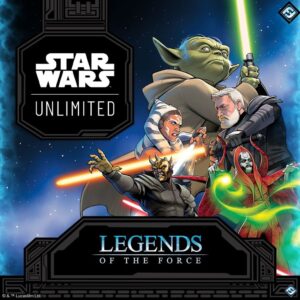
Come Out Swinging – Kylo Ren and Energy Conversion Lab
We built a deck with one of the more unique Legends of the Force Leaders, and hopefully one with a favourable match-up versus Han Solo decks.
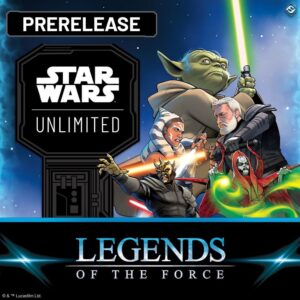
Legends of the Force: What is a Prerelease?
Star Wars: Unlimited is launching its newest set, Legends of the Force. Here’s all about the pre-release events, new techs, and cards.

